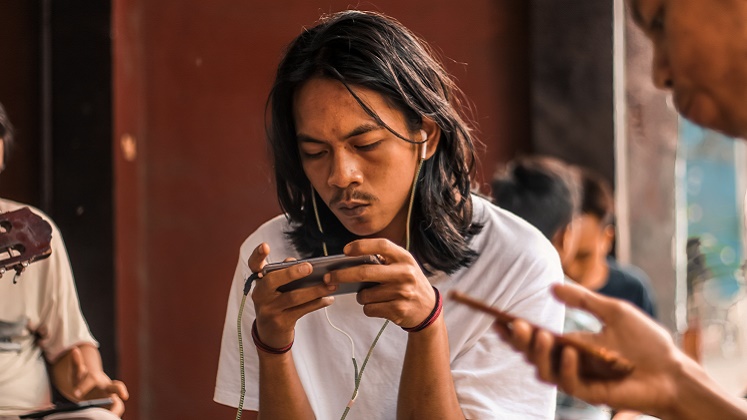In this series we publish blog posts written by our first year undergraduate students for the PB101 Foundations of Psychological Science course. In this post, Maddy Fulton considers the pros and cons of our tendency to imitate others.
Whether imitation is seen as a compliment or an insult, it is fair to say it happens often. You may have even noticed yourself being subject to it. Whether you went to the current ‘trendy’ restaurant, looked over your shoulder in a lesson and wrote the same response as your classmate, or found yourself yawning right after your friend did. These are a small collection of imitations that happen daily (maybe not copying your classmate, but definitely yawning). Have you ever thought – why does this happen? If so, let me introduce you to one theory of imitation: Social Learning Theory.
Social learning theory was first developed in the 1960s by psychologist Albert Bandura, who believed that behaviourism alone could not entirely explain learning. Instead, he suggested that learning consists of environmental and behavioural interactions. These interactions enable new knowledge and behaviours to be developed by watching others to determine whether an action should be mimicked.
Whilst social learning theory is well regarded, there are some key criticisms to acknowledge. Critics assert that the theory overlooks the fact that ‘we do not imitate everybody indiscriminately’. Instead, psychologists such as Baldwin suggest conscious choices are made to determine which members of the group we should mimic. These choices are made using cues based on characteristics such as age, health, success, and gender. Yet, these social cues used are not equally weighted. For example, we are more likely to copy an older group member because of the perception that they have encountered more experiences and are wiser. However, age cues will be traded for success cues if someone younger outperforms an older group member.
This reliance on social cues increases as decisions become more critical. As a result, we are more likely to mimic those who are successful, even if this success has been achieved through risky decision-making. The copying of risky decisions is more likely if the person making the decision is like us; sharing gender, ethnicity or beliefs. Baldwin suggests that we have ‘gotten in the habit of imitating’ as a method of self-organisation. This highlights the theory’s predominant issue:
Why do we imitate others?
Well, our imitative phenomenon is likely to be the result of cultural evolution. Whilst this sounds dramatic, the rapid growth of culture and civilisation has enabled us to alter our genetic evolution. This is because epigenetic processes relating to cultural learning have been prioritised over others, which, over time, has resulted in physiological changes to the human body. For example, the passing of knowledge relating to how to start a fire between generations has enabled us to cook food, subsequently reducing the energy requirements for digestion and decreasing the size of the digestive system itself. This increased the energy levels available to the brain, triggering the enlargement of the brain as a whole, as well as specific regions such as the prefrontal cortex, which is related to executive functioning.
In addition to the brain’s increase in size, cultural evolution has further altered its composition through the formation of mirror neurons. These specialised neurons fire in the corresponding brain regions to the observed behaviour. This has enabled us to learn necessary skills such as speaking and walking with less conscious effort. While these neurons are present throughout life, they are most active in childhood, causing most learning to occur between the ages of 3 to 16 years.
This indicates why Baldwin stated that ‘imitation is the method of personal progress’ and is ‘the essential method of his (the child’s) growth’ after conducting a child study investigating the role of imitation. Nevertheless, Baldwin’s study did not account for individual differences between children due to genetic factors that influence their ability to function socially. This highlights the need for further studies of imitative behaviour in children to be conducted.
If social learning has the capacity to influence our physiology and knowledge, what else does it affect?
Attraction! Whether you are aware of the impact of cultural transmission on attraction or not, research suggests it is significant. Maybe you have even noticed someone mirroring your body language and subtle behaviours without understanding why it is happening. Or perhaps you have caught yourself smiling after someone else…
This is a form of social learning known as the chameleon effect. This is the automatic mimicry of behaviours such as postures and facial expressions. This effect can be an unconscious influence on you when you’re around those you feel comfortable with, such as friends. It is most common in a romantic situation when you are interacting with someone you want to build a positive rapport with. This is because these nonconscious mimicry of body language and subtle behaviours occur to improve feelings of affiliation.
So, the next time you notice someone smile after you did, or suddenly getting the urge to scratch your nose after watching the individual opposite you scratch theirs… ask yourself – why does this happen? Maybe you also had an itch, or maybe it was the chameleon effect…
Nevertheless, not all mimicked behaviours are beneficial
It is important to acknowledge the downsides of social imitation. I’m sure most of us have heard of or even watched the TV show 13 Reasons Why. But did you know that within the first 19 days of the series being released, the search term ‘suicide’ concerningly rose by 20 per cent? Or that research found a causational increase of 28.9 per cent in suicides among US youths? Nevertheless, these shocking findings are not only the case for this series, but for many other films and news articles, highlighting the issue of the phenomenon known as ‘copycat suicides‘. These are suicides that are partially or entirely caused by one’s exposure to another individual’s suicide, and if not for the exposure, would not otherwise have occurred.
This alludes to the importance of questioning the beneficial extent of social learning. While social learning can increase levels of constructive knowledge, harm can be caused due to the same social cues – prestige bias and self-similarity bias, meaning we are more likely to copy the negative behaviours of those with higher social statuses, such as celebrities, influencers or those similar to us.
The takeaway
It is important to acknowledge that more research and public awareness are needed to understand the positive and potentially dangerous impacts of imitation. Moreover, it is clear how social learning is part of the human phenomenon, whether we are aware of it or not. So, the next time you see yourself following the newest fad or fashion trend, you may be reminded of the immense impact of imitative behaviour…
- This post was originally written as part of PB101: Foundations of Psychological Science, which is a core course on the BSc Psychological and Behavioural Science. It has been published with the permission of the author.
- The opinions in this post are of the author, not of the Department of Psychological and Behavioural Science or LSE.
- Cover image by Josh Sorenson from Pexels.
References
- Allan, J. (2017). Aggression (1st ed.). Macat Library. https://doi.org/10.4324/9781912282425
- Ayers, J. W., Althouse, B. M., Leas, E. C., Dredze, M., & Allem, J.-P. (2017). Internet Searches for Suicide Following the Release of 13 Reasons Why. JAMA Internal Medicine, 177(10), 1527. https://doi.org/10.1001/jamainternmed.2017.3333
- Brand, C. O., Mesoudi, A., & Morgan, T. J. H. (2021). Trusting the experts: The domain-specificity of prestige-biased social learning. PLOS ONE, 16(8), e0255346. https://doi.org/10.1371/journal.pone.0255346
- Bridge, J. A., Greenhouse, J. B., Ruch, D., Stevens, J., Ackerman, J., Sheftall, A. H., Horowitz, L. M., Kelleher, K. J., & Campo, J. V. (2019). Association Between the Release of Netflix’s 13 Reasons Why and Suicide Rates in the United States: An Interrupted Times Series Analysis. Journal of the American Academy of Child & Adolescent Psychiatry, 59(2). https://doi.org/10.1016/j.jaac.2019.04.020
- Bueno, D. (2021, February 12). IBE — Science of learning portal — Epigenetics and learning: How the environment shapes gene expression, and the possible consequences for learning and behaviour. IBE — Science of Learning Portal. https://solportal.ibe-unesco.org/articles/epigenetics-and-learning-how-the-environment-shapes-gene-expression-and-the-possible-consequences-for-learning-and-behaviour/
- Chartrand, T. L., & Bargh, J. A. (1999). APA PsycNet. Psycnet.apa.org. https://psycnet.apa.org/doiLanding?doi=10.1037%2F0022-3514.76.6.893
- David, S. (2016). The Significance of Social Learning Theories in the Teaching of Social Studies Education. International Journal of Sociology and Anthropology Research, 2(1), 40–45. https://eajournals.org/wp-content/uploads/The-Significance-of-Social-Learning-Theories-in-the-Teaching-of-Social-Studies-Education.pdf
- De Stefani, E., & De Marco, D. (2019). Language, gesture, and emotional communication: An embodied view of social interaction. Frontiers in Psychology, 10(2063). https://doi.org/10.3389/fpsyg.2019.02063
- Ellwood, C. A. (1901). The Theory of Imitation in Social Psychology. American Journal of Sociology, 6(6), 721–741. https://doi.org/10.1086/211015
- Farmer, H., Ciaunica, A., & Hamilton, A. F. de C. (2018). The functions of imitative behaviour in humans. Mind & Language, 33(4), 378–396. https://doi.org/10.1111/mila.12189
- Friedman, N. P., & Robbins, T. W. (2021). The role of prefrontal cortex in cognitive control and executive function. Neuropsychopharmacology, 47(47), 1–18. https://doi.org/10.1038/s41386-021-01132-0
- Genschow, O., Klomfar, S., d’Haene, I., & Brass, M. (2018). Mimicking and anticipating others’ actions is linked to Social Information Processing. PLOS ONE, 13(3), e0193743. https://doi.org/10.1371/journal.pone.0193743
- Hasson, U., & Frith, C. D. (2016). Mirroring and beyond: coupled dynamics as a generalized framework for modelling social interactions. Philosophical Transactions of the Royal Society B: Biological Sciences, 371(1693), 20150366. https://doi.org/10.1098/rstb.2015.0366
- Henrich, J. (2016). The Secret of Our Success: How Culture Is Driving Human Evolution, Domesticating Our Species, and Making Us Smarter. In JSTOR. Princeton University Press. https://www.jstor.org/stable/j.ctvc77f0d
- Mesoudi, A. (2009). The Cultural Dynamics of Copycat Suicide. PLoS ONE, 4(9), e7252. https://doi.org/10.1371/journal.pone.0007252
- Molenberghs, P., Cunnington, R., & Mattingley, J. B. (2012). Brain regions with mirror properties: A meta-analysis of 125 human fMRI studies. Neuroscience & Biobehavioral Reviews, 36(1), 341–349. https://doi.org/10.1016/j.neubiorev.2011.07.004
- Semendeferi, K., Armstrong, E., Schleicher, A., Zilles, K., & Van Hoesen, G. W. (2001). Prefrontal cortex in humans and apes: A comparative study of area 10. American Journal of Physical Anthropology, 114(3), 224–241. https://doi.org/10.1002/1096-8644(200103)114:3%3C224::aid-ajpa1022%3E3.0.co;2-i





